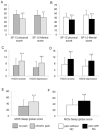Chronic pain with neuropathic characteristics in diabetic patients: a French cross-sectional study
- PMID: 24058527
- PMCID: PMC3772849
- DOI: 10.1371/journal.pone.0074195
Chronic pain with neuropathic characteristics in diabetic patients: a French cross-sectional study
Abstract
Objective: Our aim was to estimate the prevalence of distal chronic pain with neuropathic characteristics in patients with type 1 and type 2 diabetes mellitus and its impact on quality of life, mood, anxiety, sleep and healthcare utilization.
Methods: In total, 885 patients were screened and 766 diabetic patients (38.7% with type 1 diabetes mellitus, 44.8% women, mean age: 57.2 ± 14.9 years) were enrolled consecutively over a three-month period in this observational study by 85 diabetes specialists working in a hospital department or in private practice. All the patients completed a series of questionnaires for the detection of chronic pain (i.e. daily pain for more than three months) in the lower limbs and assessment of health-related quality of life (Medical Outcomes Short Form 12 scale), sleep disturbances (MOS sleep scale), depression and anxiety (Hospital Anxiety and Depression scale). Patients with chronic pain were also assessed with the 7-item DN4-interview questionnaire, the monofilament test and the Michigan Neuropathy Screening Instrument (MNSI).
Results: The overall prevalence of chronic pain with neuropathic characteristics was 20.3% [95% CI 17.4-23.1]. The MNSI examination score suggested that pain was related to polyneuropathy, in 80.1% of these patients (89.5% of those with bilateral pain). Patients with chronic pain had a poorer quality of life and more sleep disturbances, anxiety and depression than patients without pain and the presence of neuropathic characteristics was predictive of such impairments. Only 38.6% of the patients had received appropriate treatment for neuropathic pain.
Conclusions: Chronic pain with neuropathic characteristics concerns one in five diabetic patients, has a significant impact on quality of life and is not adequately managed. The close correlation between the DN4 questionnaire and MNSI results suggests that screening tools for neuropathic pain could be used in daily practice for the identification of painful diabetic polyneuropathy.
Conflict of interest statement
Figures



References
-
- Boulton AJ, Vinik AI, Arezzo JC, Bril V, Feldman EL, et al. (2005) American Diabetes Association. Diabetic neuropathies: a statement by the American Diabetes Association. Diabetes Care 28: 956–962. - PubMed
-
- Tesfaye S, Vileikyte L, Rayman G, Sindrup S, Perkins B, et al. (2011) Painful diabetic peripheral neuropathy: Consensus Recommendations on Diagnosis, Assessment and Management. Diabetes Metab Res Rev 27: 629–638. - PubMed
-
- Boulton AJ, Malik RA, Arezzo JC, Sosenko JM (2004) Diabetic somatic neuropathies. Diabetes Care 27: 1458–1486. - PubMed
-
- Hartemann A, Attal N, Bouhassira D, Dumont I, Gin H, et al. (2011) Painful diabetic neuropathy: diagnosis and management. Diabetes Metab. 37: 377–388. - PubMed
Publication types
MeSH terms
LinkOut - more resources
Full Text Sources
Other Literature Sources
Medical

